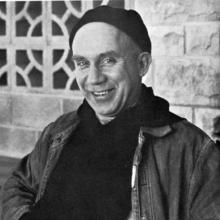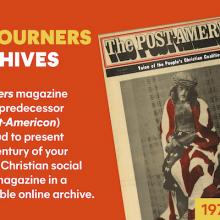Gethsemani
IN OCTOBER 1968, the renowned Trappist monk and spiritual writer Thomas Merton set out for Asia on what would be his final pilgrimage, desiring “to drink from [the] ancient sources of monastic vision and experience.” From his monastery in Kentucky, he had long dreamed of meeting with Buddhist teachers face to face, close to the sources of Eastern mysticism, and fulfilling what he believed to be the vocation of every Christian: to be an instrument of unity.
Three times during his journey Merton met with the young Dalai Lama, who would later say, “This was the first time that I had been struck by such a feeling of spirituality in anyone who professed Christianity. ... It was Merton who introduced me to the real meaning of the word ‘Christian.’”
After Merton’s sudden death in Bangkok on Dec. 10, 1968—the result of an accidental electrocution—his body was returned to the U.S. in a military transport plane that carried the bodies of soldiers killed in Vietnam, a war he had condemned forcefully. His body was laid in the earth on a hillside behind the monastery, overlooking the Kentucky woods where he lived as a hermit the last years of his life. Pilgrims from all over the world continue to visit the Abbey of Gethsemani and pray before the simple white cross that marks Merton’s grave. Why? One hundred years after his birth, the question is well worth asking. What particular magic draws seekers of every generation and of such remarkably diverse backgrounds to Thomas Merton?
SON OF A CENTURY
Merton’s appeal to postmodern sensibilities may be explained in part by his own renaissance background. Born in France in 1915 to an American mother and a New Zealand father, itinerant artists who had met in Paris, Merton spent much of his youth traveling between Europe and America. By the time he was 16, both of his parents were dead. He enrolled at Cambridge, but his raucous behavior there quickly prompted his godfather to send Merton back to the U.S., where he enrolled at Columbia University and soon thrived among an avant-garde group of friends.
More and more he found himself drawn to Catholic authors, devouring works by William Blake, Gerard Manley Hopkins, James Joyce, and Jacques Maritain. As he later described this period, something deep “began to stir within me ... began to push me, to prompt me ... like a voice.” To the shock of his friends, Merton announced his desire to become a Roman Catholic and was baptized on Nov. 16, 1938, in New York. Two years later Merton began teaching English at St. Bonaventure. After spending Holy Week of 1941 on retreat at the Abbey of Gethsemani in the hills of rural western Kentucky, Merton decided to become a Trappist monk, part of a Catholic religious order of cloistered contemplatives who follow the 1,500-year-old Rule of St. Benedict.
It was the publication in 1948 of his autobiography,The Seven Storey Mountain, set against the shadow of World War II, that established Merton as a “famous” monk and a wholly unexpected literary phenomenon. In addition to publishing spiritual meditations, journals, and poetry, during the 1960s he published penetrating essays in both religious and secular venues on the most explosive social issues of the day, the religions of the East, monastic and church reform, and questions of belief and atheism.
As a model for Christian holiness, Merton was far from perfect. In fact he took pains to distance himself from his early, more pious writings, and insisted on his right not to be turned into a myth for Catholic school children. He was a restless monk, and often chafed against his vows of stability and obedience. In 1966, during a hospital stay in Louisville, Ky., he fell in love with a young student nurse, and for some six months they had a kind of clandestine affair.
Don’t sing love songs, you’ll wake my mother
She’s sleeping here right by my side
And in her right hand a silver dagger,
She says that I can’t be your bride.
— from “Silver Dagger” by Joan Baez
It was their song — the young, winsome brunette and her silver-pated lover with the sparkly eyes.
“All the love and all the death in me are at the moment wound up in Joan Baez’s ‘Silver Dagger,’” the man wrote to his lady love in 1966. “I can’t get it out of my head, day or night. I am obsessed with it. My whole being is saturated with it. The song is myself — and yourself for me, in a way.”
He yearned for her. He was heartbroken. And he was Thomas Merton — the Trappist monk, celebrated author, and perhaps most influential American Catholic of the 20th century.
It’s a chapter of the thoroughly modern mystic’s life that is no secret to his legions of fans, detractors, and scholars of his prolific work, including the best-selling autobiography, The Seven-Storey Mountain.
Now Merton’s complex love life is the subject of a forthcoming feature film, The Divine Comedy of Thomas Merton.

